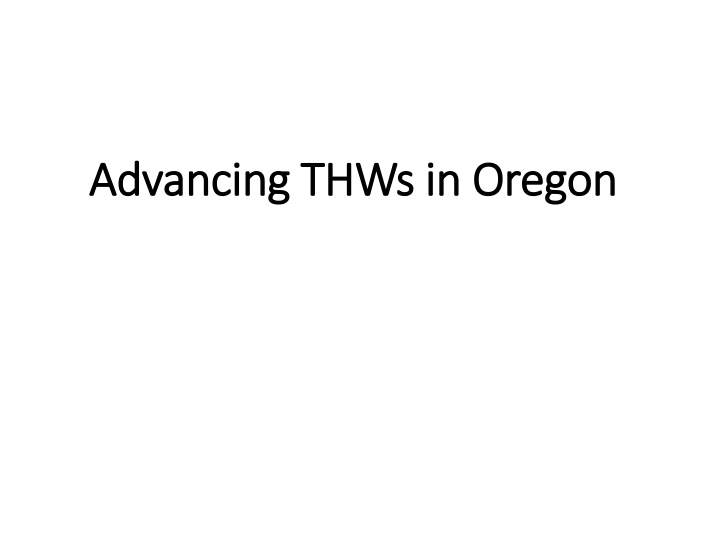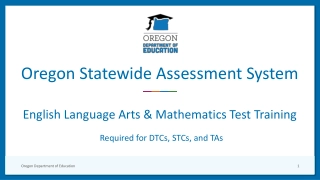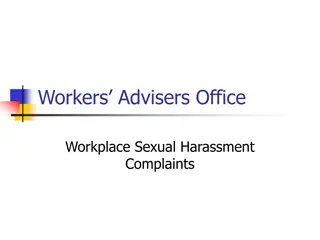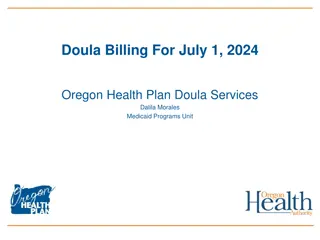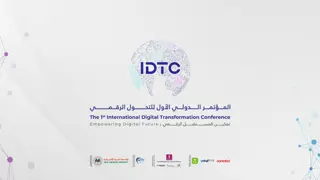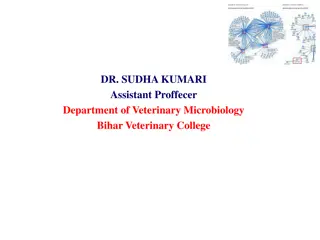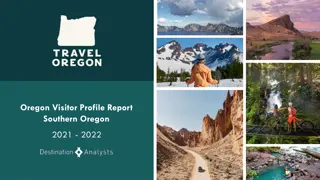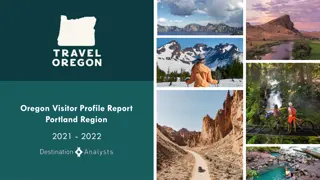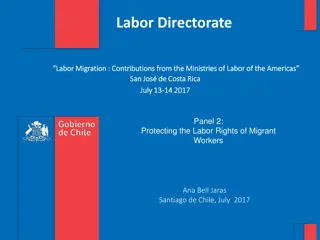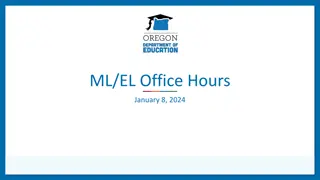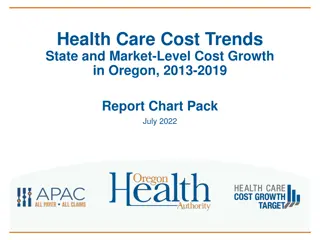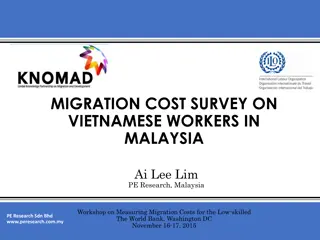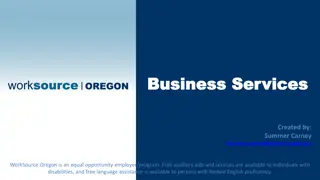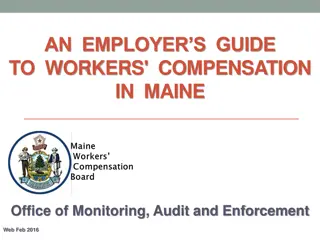Oregon Health Transformation Initiatives for Traditional Health Workers (THWs)
Oregon is focusing on integrating Traditional Health Workers (THWs) into its healthcare system to improve health outcomes. THWs play a key role in providing culturally competent care and addressing social determinants of health. The state has outlined specific requirements for CCOs to implement THW integration and utilization plans, establish payment models, and adhere to best practices to enhance access to care and address health disparities.
Download Presentation

Please find below an Image/Link to download the presentation.
The content on the website is provided AS IS for your information and personal use only. It may not be sold, licensed, or shared on other websites without obtaining consent from the author.If you encounter any issues during the download, it is possible that the publisher has removed the file from their server.
You are allowed to download the files provided on this website for personal or commercial use, subject to the condition that they are used lawfully. All files are the property of their respective owners.
The content on the website is provided AS IS for your information and personal use only. It may not be sold, licensed, or shared on other websites without obtaining consent from the author.
E N D
Presentation Transcript
Advancing THWs in Oregon Advancing THWs in Oregon Oregon s Health Transformation Efforts
THW and CCO 2.0 THW and CCO 2.0 An overview of THW-related requirements in CCO contracts
CCO 2.0 Contract and THWs CCO 2.0 Contract and THWs https://www.oregon.gov/oha/OHPB/CCODocuments/Final- CCO-contract-terms-for-5-year-contract-awardees.pdf Exhibit K Social Determinants of Health and Equity 11. Traditional Health Workers (p. 268) FIVE KEY REQUIREMENTS 1. Implement and report on a THW Integration and Utilization Plan 2. Submit and annually update their THW Payment Model Grid 3. Work to implement THW Commission s best practices 4. Hire/designate a THW Liaison 5. Submit THW data (annually starting in year 2)
1. THW Integration and Utilization plan must describe how the CCO will: Integrate THWs into the delivery of services Communicate to members and providers about the scope of practice, benefits, and availability of THW services Increase member utilization of THWs Implement THW Commission best practices including contracting with CBOs Measure baseline utilization and performance over time Utilize the THW Liaison position to improve access to members and increase recruitment and retention of THWs in its provider network THW Integration and Utilization Plan
2. CCO must establish a Payment Model Grid informed by THW Commission s Payment Model Committee and that includes: https://www.oregon.gov/oha/OEI/THW %20Documents/FINAL-Payment-Models- Grid-by-Worker-Type-with-Disclaimer- 9.25.19.pdf Different sustainable payment strategies including Fee-for-Service, alternative payment models, direct employment, and other strategies Sustainable payment models are models that pay THWs on an ongoing, long term basis Address all 5 THW types Payment Payment Model Grid Model Grid
3. CCO must implement THW Best Practices including: Contract with CBOs Align and retain THWs workforce THWs support and supervision Supervision competencies Understanding THWs provider enrollment Improve billing and payment procedures Understand benefits of integrating individual THWs Understand THWs scope of practices THW THW Commission s Commission s Best Practices Best Practices
4. CCO shall subcontract, hire a new employee, or designate an existing employee to serve as a THW Liaison responsible for: Integrating THWs into the delivery of services Addressing barriers to integration and utilization of THWs and their services Coordinating CCOs THW workforce Design the THW Integration and Utilization Plan including recruitment and retention of THWs Provide TA to help THWs become enrolled providers at CCOs Assist and coach members in utilizing THW services Provide assistance and support for establishing THW payments and rates Member access and utilization of THWs in clinic and community settings Educating providers and supervisors on THW scope of work, model, and oversight, as well as ensuring THWs are integrated into member care teams THW THW Liaison Liaison
5. CCOs must collect and submit data related to THW efforts including: An assessment of member satisfaction of THW services Ratio of THWs to total number of members Number and type of THWs by all 5 worker types FTE and location of employment (clinic or community based) Number of member requests for THWs Number of member referrals to THWs Number of encounters THW Demographics (race/ethnicity, language, and disability) Payment model types THW Data THW Data Submissions Submissions
THW Logic Model THW Logic Model- -ish ish Organizing Oregon s efforts to advance THWs through health transformation requirements
What are we doing? What are we doing? THW Commission s Vision and Mission OHA s strategic goal to eliminate health inequities by 2030 Our vision: Traditional Health Workers in Oregon will be fully recognized and compensated for their unique contributions to transforming health and social services, creating health equity and promoting social justice in our diverse communities. Leveraging CCO 2.0 and health transformation efforts to establish CCO requirements to increase THWs in our communities. Our mission: To guide and advise OHA to create policy and rules that ensure integrity, fidelity and promote the advancement of the THW workforce.
Why are we doing this? Why are we doing this? THWs help us provide person/family/community centered whole-person care Helps us honor and uplift community-based wisdom and practices Helps us create easier access to services for our communities Serves as a pathway to meaningful employment for people with lived experience that is sustainable, stable, and provides a living wage Helps us elevate the THW profession and acknowledge it as an honored profession
Levers of Change Levers of Change 1 THW Integration and Utilization Plan THW Payment Model Grid 2 THW Commission s Best Practices 3 4 THW Liaison Position THW Data Collection and Submission 5
Problem Statement: Problem Statement: Oregon continues to be plagued by structural racism and other oppressions that perpetuate health inequities for our communities. Traditional Health Workers play a unique role in combatting this by: breaking down barriers to social determinants of health, providing whole person care and person/family/community driven support, and filling in gaps in care of the health system. Inputs Outputs Levers of change Outcomes Activities to be undertaken Results expected Increase THW integration efforts Increase community and provider education Increase promotion of THW services to members Increase in effective support for THWs Increase data collection, reporting, and oversight Increase organizational infrastructure and investments Increase and diversify payment models Increase provision of technical assistance for THWs and providers Increase in # of THWs (all 5 types) Increased knowledge and understanding of the value and availability of THWs Increased use of THWs by members THWs are provided with effective supervision and support Improved quality assurance and monitoring of THWs and understanding of ROI Increased staffing and funding to support THW workforce Increase in sustainable payment models that support long term employment Increased support for THWs and providers in supporting THWs Reduction in health inequities for CCO members 1. THW Integration & Utilization Plan 2. THW Payment Model Grid 3. THW Best Practices 4. THW Liaison 5. THW Data Increased access to SDOH services for our communities A robust, well supported, respected, valued, and integrated THW workforce
What parts of this logic model and information resonated for you? Where did we miss the mark or what is missing? Discussion Discussion questions questions How would you improve it? Does this help articulate or connect CCO 2.0 THW requirements to our vision or goals for THWs in Oregon?
